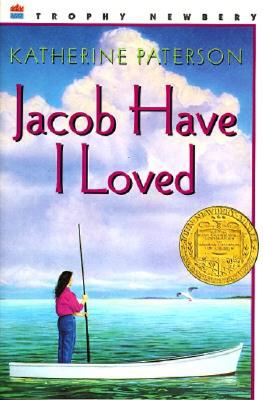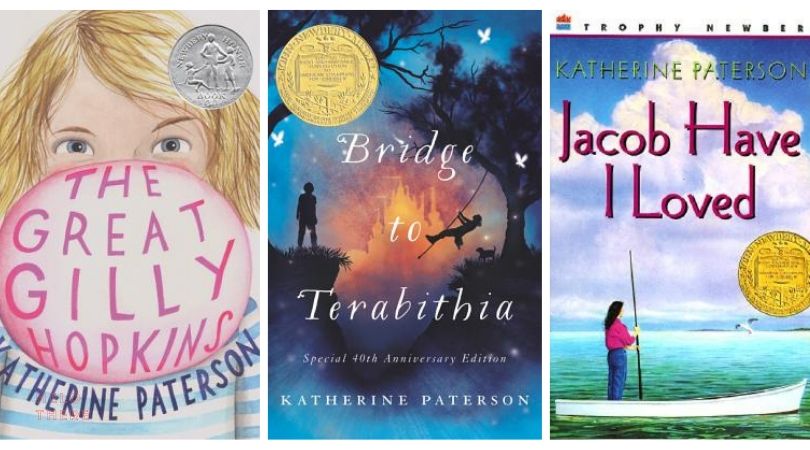craft review by Anne-Marie Strohman
As we saw in the first post of this series, on Bridge to Terabithia, an ending that feels inevitable and surprising includes a scene that cements the character’s change and shows them moving toward a future where that change sticks, and also offers a surprise, in this case a surprising emotion–hope.
Jacob Have I Loved

Katherine Paterson’s young adult novel Jacob Have I Loved, published in 1980, tells the story of Louise and her twin sister Caroline. (The title references the biblical twins Esau, the elder but rejected brother, and Jacob, the younger and favored one, see Romans 9:13.) Caroline is the perfect Methodist daughter, a shining example of femininity on the small island where the family lives. Louise is rough-and-tumble, preferring crabbing to music. Louise feels like a blight on the family in contrast to Caroline and must come to terms with her place in the world, her role in creating it, and the possibilities she has for changing it.
The novel breaks many conventions, especially with its ending. The book is narrated by an adult looking back mainly at the years she was a teenager. The story takes place between 1941 and 1945, but the last five chapters of the book cover 1945, when Louise is out of high school, and move through her years of nursing school, working in Appalachia as a nurse-midwife, getting married, and having a baby. Because the novel begins with an adult Louise narrating, ending with an adult Louise makes sense. However, the novel ends with a birth, which seems odd in a story for teens.
Closing the Emotional Arc
This ending and the scenes leading up to it offer the completion of Louise’s emotional journey—the inevitable ending. Louise’s main emotional conflict is that she feels slighted because her parents favor her twin sister, or so she believes. In retellings of the twins’ birth story, no one is quite sure what happened with Louise while everyone was panicking about Caroline, even when Louise presses the question:
The story always left the other twin, the stronger twin, washed and dressed and lying in a basket. Clean and cold and motherless. (20)
Louise’s emotional arc ends with this and other childhood beliefs being challenged. For instance, she doesn’t fit the stereotypical Methodist ideal girl, and she feels unaccepted in the community at large. But her parents let her crab on her own, wear overalls, hang out all day with Call (a slightly older boy), and eventually crab and tong for oysters with her father. She feels the societal constraints, but only later does she appreciate how much her parents set those aside for her.
Throughout the book she sees Call as unlovable, ungainly, unfunny, and basically undesirable—the perfect companion for someone as unloved as she felt. But when Call comes back from the war and says he is planning to marry Caroline, Louise is shocked. She thinks of Call “hers.” But as he tells her, “‘You never did think I was much to brag about, now did you?’” (227).
She continually sees herself as neglected and unloved, but in the climactic scene, Louise’s mother says she will miss her more than she misses Caroline, who has left for music school. Her deepest childhood belief–that she is unloved–is turned on its head with her mother’s confession.
Perhaps Louise’s biggest misconception is that she is trapped on the island. In the climactic scene her mother disabuses her of this notion:
“Of course you may leave,” she says. “You never said before you wanted to leave.” (247)
Louise sees her mother as trapped in the same way, her life wasted on an island full of uneducated people living with a mother-in-law who abuses her with bible verses. But her mother says,
“I am what I wanted to be. . . . I chose. No one made me become what I am. . . . I’m not ashamed of what I have made of my life.” (247)
Just after this moment, Louise finally comes to terms with the fact that she is the one holding herself back, not admitting to herself what she wants, and blaming everyone around her for how she feels. After this almost-fight with her mother, her realization of her misconceptions “allowed me at last to leave the island and begin to build myself as a soul, separate from the long, long shadow of my twin” (247). This last line indicates Louise’s trajectory of change.
Making Change Permanent
This transformation, however, is limited unless we see evidence of Louise “build[ing] herself as a soul.” We see it in the story of her college and early working years in Appalachia. But the story comes full circle by recreating Louise and Caroline’s birth scene this time with Louise in the role of midwife instead of strong and neglected baby. She herself goes through extreme measures to take care of the weaker twin, warming her carefully in the oven, wanting everyone else to stay away, and forgetting entirely about the older, stronger boy.
But in one moment, she re-envisions her own birth, giving this boy the experience she never felt she had. When the new twins’ grandmother comes into the kitchen, Louise reacts,
“Where is the other twin?” I asked, suddenly stricken. I had forgotten him. In my anxiety for his sister, I had completely forgotten him. “Where have you put him?”
When she is told he’s sleeping in the basket, she responds,
“You should hold him. . . . Hold him as much as you can. Or let his mother hold him. . . . then let Essie nurse him.” (262-63)
As she lives the anxiety of her parents and grandmother at her own birth, she also makes room for the stronger twin to be loved and nursed, to not be forgotten as she was. She reenacts her own birth, both experiencing empathy with the past and re-envisioning it.
The Surprise of a New Role
While a traditional mirror scene shows the character acting differently at the end than they did at the beginning, Paterson provides a twist by changing Louise’s role in the scene. At the beginning, she also focuses on how Louise is the same as her mother and other caregivers, not different. The second twist is Louise’s realization that she can and must act differently.
Paterson creates an ending that is inevitable and surprising. Louise’s character arc is completed in the climactic scene: she has gained a new perspective and can move from the island to choose her own life. In the ending, she needs to show that she can act according to how she has grown to prove that that growth is real.
While some critics at the time felt like the change of pace in the last section disrupts the novel, the scenes of her college and early working experiences are there to prove that Louise is building herself a soul outside of the constraints of Rass Island, and to get her into a position where she might realistically be in the final scene as a midwife.
By recreating the twins’ birth, Paterson chooses an unconventional ending for a children’s novel—the adult Louise’s proof of growth a long time after the events that shape her later life. As a Kirkus Review from October 1980 points out, “Paterson has to get into these later years to make the point, and to avoid the instant realizations that substitute in too many juvenile novels.” The surprising nature of the ending with its passage of time and adult protagonist also merges with a conventional ending strategy of creating a mirror scene. It is through this balance of the familiar and the surprising that Paterson leads readers to a satisfying ending.
Actions:
- Think outside the box. What are some possible endings for your novel that go beyond the expected?
- Can your protagonist find empathy for their antagonist?
- Try recreating an origin or backstory scene as your ending.
Next week, see how the surprising and inevitable plays out in The Great Gilly Hopkins.
Anne-Marie Strohman (co-editor) writes picture books, middle grade novels, and young adult short stories and novels. She is trained as a teacher, an editor, and a scholar, specializing in Renaissance Literature. She holds an MFA in Writing for Children and Young Adults from Vermont College of Fine Arts and is an active member of SCBWI. Find her at amstrohman.com and on Twitter @amstrwriter.

COMMENTs:
0